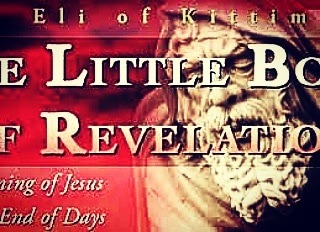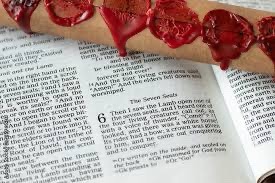
Author of “The Little Book of Revelation.” Get your copy now!!https://www.xlibris.com/en/bookstore/bookdetails/597424-the-little-book-of-revelation
447 posts
Eli Of Kittim Amazon Author Page
Eli of Kittim Amazon Author Page

Eli of Kittim Amazon Author Page
This is my Amazon Fan Page. The title of my non-fiction book clarifies what the book is about, namely, The First Coming of Jesus at the End of Days. The book is based on biblical scholarship and its argument is that——according to the New Testament epistles——the first coming of Jesus will take place at the end of the world (see e.g. Hebrews 9:26b; 1 Peter 1:20)! This can be corroborated throughout the Bible. I have done extensive follow-up research using the original Greek New Testament to demonstrate the legitimacy of my claim!
-
 wanderinghybrid liked this · 2 years ago
wanderinghybrid liked this · 2 years ago -
 koinequest liked this · 2 years ago
koinequest liked this · 2 years ago
More Posts from Eli-kittim

Eli of Kittim Author Page on Facebook

Eli Kittim - The Little Book of Revelation: The First Coming of Jesus at the End of Days
伊莱·基蒂姆 启示录小书:耶稣在末日的第一次降临
एली किट्टिम - रहस्योद्घाटन की छोटी पुस्तक: दिनों के अंत में यीशु का पहला आगमन
Эли Киттим - Маленькая книга Откровения: Первое пришествие Иисуса в конце дней
אלי כטים - ספר ההתגלות הקטן: ביאתו הראשונה של ישוע באחרית הימים
إيلي كيتيم كتاب الرؤيا الصغير: المجيء الأول ليسوع في نهاية الأيام
Ελι Κιττίμ - Το Μικρό Βιβλίο της Αποκάλυψης: Η Πρώτη Παρουσία του Ιησού στο τέλος των Ημερών


The Seven Seals of Revelation
Eli Kittim
In ancient times, papyrus scrolls with classified information contained several wax seals (Gk. σφραγίς) which ensured that only the appropriate recipient could read the document. Likewise, the Bible uses the term metaphorically to convey apocalyptic information about upcoming events. The seven-sealed scroll reveals seven chronological disclosures that will come in rapid succession. Each seal represents a coming event that will have a major impact on the world. The breaking of the seven seals occurs in Rev. 5–8. The first four seals are known as the Four Horsemen of the Apocalypse.
The first seal represents the first coming of Christ, who commences the sequence of end time events (Rev. 6:1-2). He rides a white horse, which is also mentioned in Rev. 19:11 using nearly identical language. In Rev. 6:2 (NJB), the white rider goes “from victory to victory” (Gk. νικῶν καὶ ἵνα νικήσῃ). The biblical term "victory" is intimately associated with Christ's resurrection from the dead, which ultimately results in the conquering of death itself (see 1 Cor. 15:54, 57). The terms νικῶν and νικήσῃ are based on the Greek word νικάω (nikao), which means to “overcome” or to be “victorious.” The word nikao can only refer to an overcomer in Christ and cannot possibly be attributed to an Antichrist figure (see e.g. Rev. 2:7, 11, 17, 26; Rev. 3:5, 12, 21). Also, the white horseman wears a stephanos crown, which is worn by believers and victors in Christ (see e.g. Mt. 27:29; Jas. 1:12; 2 Tim. 4:8; 1 Pet. 5:4; Rev. 2:10; 4:4; 14:14). The Stephanos “crown” is therefore a symbol of victory for the believers in Christ. Accordingly, the Antichrist would not wear a stephanos crown. We are also told that the rider of the white horse “was holding a bow” (Gk. toxon), which represents God's covenant with the human race (see Gen. 9:13). The Septuagint (LXX), an early Greek translation of the Hebrew Bible, translates the Hebrew word קַשְׁתִּ֕י (qaš·tî), which means “rainbow,” with the Greek word “toxon” (bow) in Gen. 9:13! In Rev. 6:2, the Greek word “toxon” is the same word that is translated in the English Bible versions by the word bow. Therefore, the Antichrist would not be “holding a bow,” representing God's covenant. And there are no counterfeit signs in the Bible. That’s why all references to God, Christ, and to the saints are always couched in white imagery (see e.g. Isa. 1:18; Dan. 7:9; Mt. 28:3; John 20:12; Rev. 1:14; 2:17; Rev. 3:4-5, 18; 4:4; 6:11; Rev. 7:9, 13-14; 14:14; 19:14).
The second seal represents the coming of the Antichrist (Revelation 6:3–4), the red horse. The red horseman represents the last king who comes out of the final world empire, which is represented by the red seven-headed dragon with ten horns. World War 3 commences with the red rider, who was given a huge and mighty sword and granted permission to slaughter mankind.
The third seal represents economic collapse (Revelation 6:5–6). The rider of the Black horse holds “a pair of scales,” which merchants used in order to barter for their goods. In those days, meals will be so expensive that it will cost a whole day's wages just to have one.
The fourth seal (Revelation 6:7–8) introduces the “deathly pale” horse whose “rider was called Death, and Hades followed at its heels.” The fourth horse mainly represents a global food crisis, famines, and pandemics that kill off “a quarter of the earth[‘s]” population, coupled with wars and other devastations.
The fifth seal represents the martyrs of the faith throughout the centuries, but especially those who will be killed during the great tribulation (Revelation 6:9–11). The clue is given in verse 11 where “they were told to be patient a little longer, until the roll was completed of their fellow-servants and brothers who were still to be killed as they had been” (cf. Mt. 24:9). These martyrs include the 144,000 who are mentioned in Revelation chapter seven. Rev. 7:13-14 explains that the 144 thousand are the elect “who have been through the great trial.” However, Rev. 7:4-8 is obviously describing not just the tribulation saints but the entire church as a whole. In fact, Revelation 7:9 gives us the identity of the 144 thousand by stating that they’re “a huge number, impossible for anyone to count,” and that they come from every nation on earth.
The sixth seal represents nuclear war, the resurrection, and the rapture (Revelation 6:12–17). The first part of the sixth seal represents nuclear war, which is described as “a violent earthquake” that causes the sun to turn black and the moon red. This event precedes the day of the Lord, according to Joel 2:31 (italics mine):
“The sun shall be turned to darkness, and
the moon to blood, BEFORE the great and
awesome day of the LORD comes.”
There are other devastations as well, such as massive upheavals of the earth's crust and space debris hurtling back to earth, islands and mountains are moved out of their place, as everything will be shaken to its foundations (cf. Hebrews 12:27). It is right after this event that Christ will appear to rapture the elect. See Matthew 24:29-31 (italics mine):
“Immediately AFTER the distress of those
days the sun will be darkened, the moon will
not give its light, the stars will fall from the
sky and the powers of the heavens will be
shaken. And then the sign of the Son of
man will appear in heaven; … And he will
send his angels with a loud trumpet to
gather his elect from the four winds.”
Similarly, Daniel 12:1-2 indicates that the general resurrection of the dead will occur after the great tribulation, which will be an event “unlike any other from the nation’s beginning up to that time.” In line with these passages, the sixth seal indicates that after the great tribulation “all the kings of the earth, the governors and … the whole population, … hid in caverns and among the rocks of the mountains,” and “they said to the mountains and the rocks, 'Fall on us and hide us away from the One who sits on the throne and from the retribution of the Lamb. For the Great Day of his retribution has come, and who can face it?' “ (Rev. 6:15-17). This pericope is taken from Isaiah 2:19, which describes Yahweh rising from the dead to shake the earth:
“they will go into the caverns of the rocks
and into the fissures of the earth in terror of
Yahweh, at the brilliance of his majesty,
when he arises to make the earth quake.”
We know from 1 Thess. 4:16-17 that the resurrection and the rapture happen simultaneously. Thus, the aforementioned passages coalesce to give us the big picture, namely, that the sixth seal represents the resurrection and the rapture, which will occur right after the Great Tribulation!
The seventh seal represents the Day of the Lord (Rev. 8:1-5). The prelude to the day of the Lord begins with a short respite, as “there was silence in heaven for about half an hour” (verse 1). It represents the lull before the storm. This is the close of the tribulation period (Satan’s wrath) and the beginning of the Day of the Lord (God’s wrath), as the severity of the judgments begin to increase with the coming of the seven trumpets. But before the sounding of the seven trumpets, an “angel took the censer and filled it from the fire of the altar, which he then hurled down onto the earth,” causing massive earthquakes and devastations (verse 5). Thus, the seventh seal represents the commencement of the Day of the Lord!

Is Mara bar Serapion’s Letter a Forgery?
Eli Kittim
The letter has been claimed to include no
Christian themes.
— Wiki
Mara bar Serapion was a stoic philosopher. He is noted for a lengthy letter that he wrote to his son. The letter was composed in Syriac, written sometime between 73 AD and the 3rd century. Many Christian apologists have suggested that Mara bar Serapion is alluding to Jesus Christ in this letter. But there are several problems with that theory.
First, a nonChristian like Mara bar Serapion would never have referred to Jesus as a “king.” Only dedicated and reborn Christians refer to Jesus as their Lord of lords and kings of Kings, not pagans.
Second, Jesus was not known as a “king.” In fact, according to Bruce Chilton and Craig A. Evans (“Studying the Historical Jesus,” pp. 455–457), “the term ‘king of the Jews’ has never been seen in the Christian literature of antiquity as a title for Jesus.”
Third, Jesus was not known as a “wise king.” The only Jew known to be a “wise king” was King Solomon, who was in fact a *king,* and whose *wisdom* was known throughout the ancient world. What is more, King Solomon is well known for being the author of many books of *wisdom* in the Bible.
Fourth, Mara bar Serapion does not even mention the terms “Jesus” or “Christ.” And when referring to famous heroic philosophers who died, and what happened after their death, he never mentions Jesus’ resurrection. Even if he didn’t believe it, he would have, at least, mentioned the *rumor* of Jesus being raised from the dead. The fact that he doesn’t mention it at all means that he’s not talking about Jesus:
[Robert E.] Van Voorst adds two factors
that indicate Mara was not a Christian, the
first being his failure to mention the terms
Jesus or Christ. The second factor (also
supported by Chilton and Evans) is that
Mara's statement that Jesus lives on based
on the wisdom of his teachings, in contrast
to the Christian concept that Jesus
continues to live through his resurrection,
indicates that he was not a Christian.
— Wiki
Fifth, the language of the document suggests that Mara bar Serapion is referring to an actual king who enacted new laws and established new practices. For example, Jewish tradition ascribes ritual hand washing and eruvin to King Solomon, who also served as a Judge (e.g. the “Judgment of Solomon”). He was also responsible for building the first temple, and for instituting new laws of how the temple services would run:
Nay, Socrates did ‘not’ die, because of
Plato; nor yet Pythagoras, because of the
statue of Hera; nor yet the Wise King,
because of the new laws which he enacted.
— Wiki
Sixth, there’s something very odd about the reference to the Jews in this letter. This is quite a long letter, which is based entirely on Greek philosophy. Scholars are in agreement that Mara bar Serapion was a Stoic philosopher and a pagan. As a rule, Stoic philosophers held Jewish teachings in contempt, and so they would never have placed them on a par with the teachings of Socrates, Plato, and Pythagoras. We know this from the apostle Paul who was scoffed at when preaching to stoic philosophers in Athens (Acts 17:15-34). The addition of the “Jewish” element, therefore, reads like a non sequitur, like a strange interpolation that doesn’t belong there… It sounds as if someone added it at a later time. And it seems as if the author (or editor?) got things wrong. Pythagoras was not burned, and King Solomon was not killed. And the expulsion of the Jews might be a reference to the deportation of the Northern Kingdom in 722 BC, or to that of Judah in 586 BC:
The letter refers to the unjust treatment of
‘three wise men’: the murder of Socrates,
the burning of Pythagoras, and the
execution of ‘the wise king’ of the Jews.
— Wiki
Now that I have offered my critique, let’s actually read that portion of the letter that apologists have employed time after time as evidence for the historicity of Jesus. Do you think that this pericope constitutes strong evidence for the existence of Jesus? Hardly! Not by a long shot:
For what benefit did the Athenians obtain
by putting Socrates to death, seeing that
they received as retribution for it famine and
pestilence? Or the people of Samos by the
burning of Pythagoras, seeing that in one
hour the whole of their country was covered
with sand? Or the Jews by the murder of
their Wise King, seeing that from that very
time their kingdom was driven away from
them? For with justice did God grant a
recompense to the wisdom of all three of
them. For the Athenians died by famine;
and the people of Samos were covered by
the sea without remedy; and the Jews,
brought to desolation and expelled from
their kingdom, are driven away into every
land. Nay, Socrates did “not” die, because
of Plato; nor yet Pythagoras, because of the
statue of Hera; nor yet the Wise King,
because of the new laws which he enacted.
— Wiki

The Official Website of “The Little Book of Revelation”
From Goodreads Author and Bible teacher Eli Kittim
The Official Website of “The Little Book of Revelation: The First Coming of Jesus at the End of Days”
Το Μικρό Βιβλίο της Αποκάλυψης: Η Πρώτη Παρουσία του Ιησού στο τέλος των Ημερών
Από τον συγγραφέα και Βιβλολόγο ´Ελι Κιττίμ.
Νικητής του βραβείου Θρησκείας και πνευματικότητας 2015 στο Goodreads.
Ένα συναρπαστικό βιβλίο που υποστηρίζει την ελληνική καταγωγή του Ιησού (γραμμένο στα αγγλικά).
To buy this book, click on the link below. ⬇️
Για να αγοράσετε αυτό το βιβλίο, ακολουθήστε τον παρακάτω σύνδεσμο: ⬇️
δικτυακός τόπος για «Το Μικρό Βιβλίο της Αποκάλυψης: Η Πρώτη Παρουσία του Ιησού στο τέλος των Ημερών» ⬇️